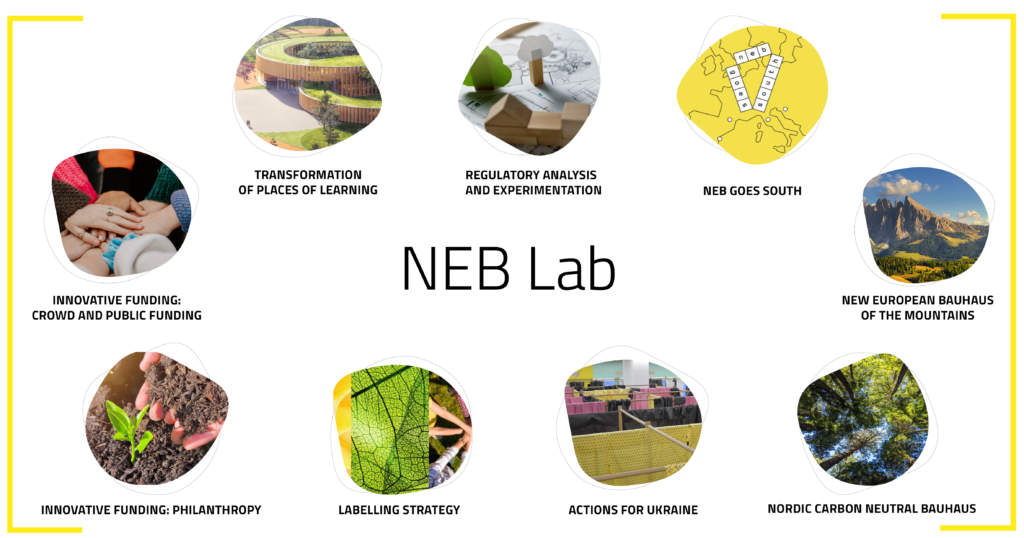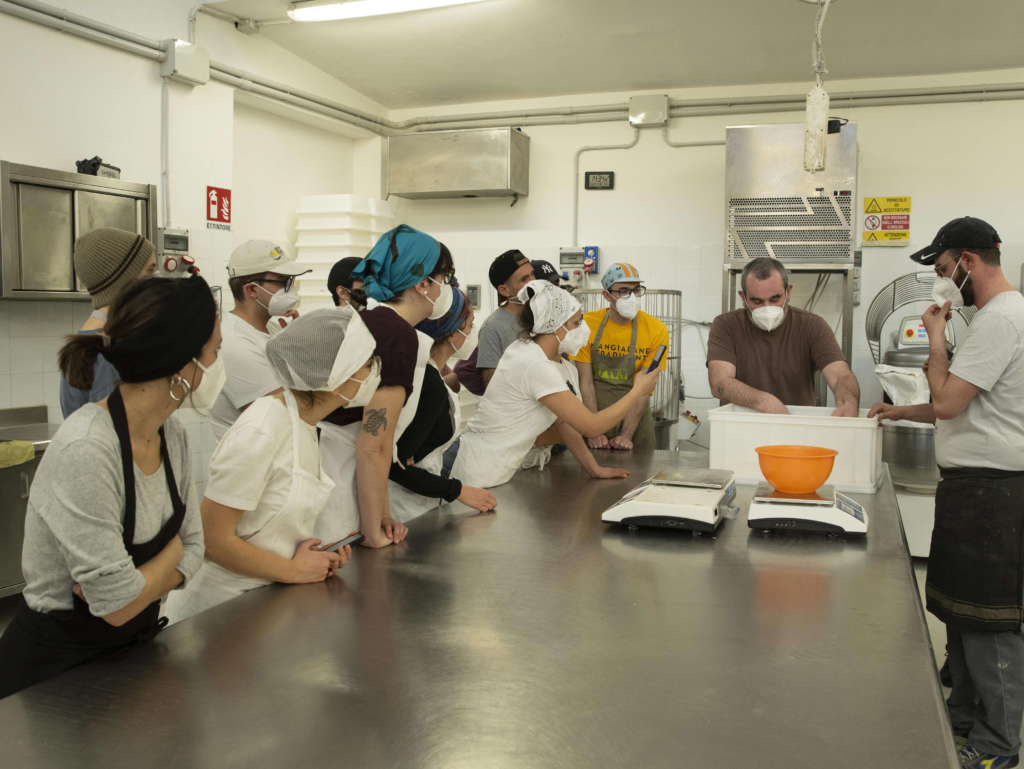Interview with Stephen Quest*, Director-General of the Joint Research Centre (JRC)
The New European Bauhaus (NEB) is an environmental, economic, and cultural initiative launched by the European Commission in 2020 to enable the green transition of our societies. It brings a creative and cultural dimension to the European Green Deal in mobilising inventive minds across disciplines to imagine a more sustainable, beautiful, and inclusive living. Its participatory and transversal approach encourage all of us to join the movement and reflect on comprehensive solutions to the many, interconnected challenges we face, from climate change to social and spatial inequalities. The NEB is developed by the Joint Research Centre (JRC), the Commission service which carries out research and manages knowledge to provide independent scientific advice and support to EU policy. Stephen Quest, the Director-General of the JRC, reflects on the spirit, objectives, and first impacts of the New European Bauhaus in terms of education and knowledge sharing.
Why is it interesting to consider the New European Bauhaus through the lens of learning and knowledge sharing?
Scientists have told us for over 30 years that the planet cannot sustain our current lifestyle. It is our collective responsibility to imagine new ways to live without further damaging our environment. This requires not only teaching the next generations to respect and protect biodiversity, but also being ready to unlearn harmful behaviours and change our own mind-sets. The New European Bauhaus shows that this shift is not only necessary and possible but can also be incredibly exciting. In highlighting the work of those who develop alternatives and creative solutions across sectors and disciplines, it gives us hope, perspectives, and a chance to learn from one another. There is, at the core of the initiative, a trust in our collective knowledge and intelligence. This is why we began with an open invitation to present inspiring examples of sustainable practices, share ideas, and define together the NEB’s ambitions and priorities. During this co-design phase, we collected more than two thousand contributions, as well as hundreds of papers and essays submitted by individuals and organizations alike. This defining period revealed a strong desire for change beyond marginal solutions, and a general interest in sharing formal and informal knowledge at the nexus of science, technology, and creation. Importantly, it confirmed that the NEB should remain an adaptable framework for future actions, open to experimentation and shaped by its community.

© European Union – The 6-month co-design phase, from January to June 2021
You mention experimentation, is this where we should situate the reference to the Bauhaus—the famous art school founded more than 100 years ago in Germany?
Precisely. The Bauhaus was conceived as a host to new modes of creative experimentation. It was built on the idea that new learning methodologies are essential for shaping new skills and knowledge, and ultimately provide solutions to emerging challenges. The pedagogy of the school sought to dissolve the boundaries between arts, crafts, and industry, but also—to a certain extent—shift resources and agency from the elite fringes of the German society to broader segments of its population. The legacy of the Bauhaus can be found in the shared belief that we need novel approaches to drive transformative change, and that we should all—without discrimination of any kind—have a chance to shape this change. On top of the three complementary NEB values—sustainability, aesthetic/quality of experience, and inclusion—the NEB adopted three working principles that emerged from the co-design phase: a transdisciplinary approach, a participatory process, and an engagement at multiple levels. These principles set clear ambitions about how we want to achieve our objectives, i.e., working beyond the silos of disciplines and the distinction of formal and informal knowledge, supporting communities to create and govern their own projects, and collaborating across sectors and scales, from local actions to global thinking. The NEB Community in all its diversity gives life to this initial statement of intent. Local and international organisations across Europe, in fields such as education, heritage, forestry, housing, or fashion (among many others), come together to present their work and explore ways to combine efforts. In the process, we all become more aware of our own standpoints and blind spots, we gain distance, and eventually an opportunity to see things with each other’s eyes. This is also true for our group of experts, the High Level Round Table members, who add their diverse cultural and geographical pathways from Asia, Africa, and Europe to the multiplicity of their expertise.
The NEB Community counts more than 600 individuals and organisations, how do they concretely learn from one another and create together?
On that topic, let me first congratulate #DiCultHer for recently joining the NEB Community as an official partner! It is particularly important for the New European Bauhaus to work with partners in the creative and cultural sectors. Back to your question, which raises a crucial point: we know that all the organisations and individuals who joined the NEB have knowledge, competencies, and skills to share, but what are the means at our disposal to circulate this knowledge, and support the implementation of its concrete application? A first response comes in the shape of our NEB Lab, a think and do tank for prototyping projects and harvesting stories and experiences. In this living laboratory, projects are proposed and led either by the Commission or by different consortia of official NEB Partners (i.e., non-for-profit entities) and Friends (i.e., businesses and public authorities). It is a place for the Community to collaborate on concrete goals and learn by doing. Nine projects are currently under development, and our objective is that their outcome will help constitute a series of toolkits and guidelines at the disposal of future projects-makers.

© European Union – NEB Lab projects, as of November 2022
Many NEB Partners come from the education sector—does the NEB Lab currently hosts projects dedicated to education?
Indeed, the largest segment of our partners comes from the fields of research and education (universities, research institutes…etc.), and many more are involved in different forms of knowledge sharing initiatives. The first NEB Lab project I would like to mention is the call for the Transformation of Places of Learning, led by the JRC. This call opened in February 2022, and will close on December 31st, 2022, so applications are still welcome! It is an invitation to share projects focused on the transformation of physical places of learning (e.g., the (re)designing of schools, libraries, community centres…etc.), the introduction of innovative pedagogical methods, and the building of meaningful relationships with local communities. The idea is again to complement the reflection on what we learn with a broader questioning on the context of this learning: where and how will we acquire new skills tomorrow? who will pass on knowledge and get access to it? The call has received so far more than 100 proposals coming from across and beyond the EU. The projects are extremely diverse in scale and nature, from universities looking to involve students in the renovation of their campus to artists setting up workshops on climate education for children. Our objective is to support all the applicants in encouraging synergies and associations between them, but also in matching the competencies and resources of our NEB Community with their specific needs. This call is a fantastic opportunity to bring together a network of passionate teachers, architects, students, community activists, innovators, and investors focusing on knowledge and education as drivers of change. The second NEB Lab project I would like to draw attention to is NEB goes South, a project initiated by six architecture schools in Southern Europe (Porto, Valencia, Toulouse, Bologna, Zagreb, Athens). Climate change brings similar challenges to countries in Southern Europe, such as heat islands, desertification, or drought. NEB goes South analyses the specificities of those emergencies to find ways to best protect the region’s shared cultural and natural heritage. The partners have organised a series of conferences and are currently developing workshops through which their students will get an opportunity to work together towards sustainable solutions for the region, reflecting on vernacular Mediterranean architecture, bio-sourced materials, or circular construction.

© European Union – The Madre Project is a one-of-a-kind school using bread making to connect local communities, places, and practices in Chiaravalle, a rural district of Milan, Italy. The project started officially in February 2022, and joined the NEB call for the Transformation of Places of Learning.
In June this year, the Council of the European Union adopted a Recommendation that established learning for environmental sustainability as one of the priority areas in education. Has there been initiatives from schools and universities—outside the NEB Lab—to incorporate the values of the NEB and its integrated approach in their programmes?
Yes, we have seen a strong engagement from the education community and academia. Of course, there is a demand from young people to learn about anthropogenic climate change, the biodiversity loss, and ways to build a more symbiotic relationship with our natural environment. Aalto University, for example, has been one of the very first partners of the NEB. Its staff and students actively advance change on topics such as sustainable fashion or the use of digital tools to help cities reduce their carbon emissions. 2022 was also the European Year of Youth, and we were happy to see initiatives under Erasmus+[1] adopting a NEB angle. For example, both the European Innovative Teaching Award and eTwinning, which offers a platform for primary and secondary European schools to collaborate and develop projects, chose this year to put the spotlight on teaching initiatives, framed around the NEB values. It is very interesting to see the NEB approach translated in learning activities, from high schoolers discussing inequalities in the face of climate change to children developing their sense of place and care in exploring their neighbourhoods. In the same spirit, the NEB collaborates with the Education for Climate Coalition, a community of students, teachers, and education stakeholders who challenge themselves to find new ways to teach sustainable behaviours. Educators work for example on bringing water saving habits to schools, they use mapping tools (e.g. the European Atlas of the Seas) to help pupils visualize the impact of climate change, or exchange useful education materials from all over Europe. Finally, DiscoverEU—another Erasmus + programme that donates free travel passes to 18-year-old young people and encourages them to explore Europe by train—will soon open a New European Bauhaus Route. The Route will give young people the ‘courage to be utopian’[2], taking them to places that have undergone radical transformations over the past years and embraced more sustainable, beautiful, and inclusive lifestyles. More broadly, the NEB’s search for integrated solutions resonates with system thinking and the context-based approach adopted in the creative sector. The framework of the initiative can be used by educators to help learners become systemic and critical thinkers, develop agency, adapt their responses to rapidly changing contexts, and collaborate with others.
In September, the President of the European Commission announced the 2023 European Year of Skills—what are the NEB’s actions towards lifelong learning and re/upskilling?
As emphasized earlier, the New European Bauhaus has a lot to do with helping us adapt and reinvent our lifestyles. We know that new skills are required to shape a new world. Let me first stress that inclusivity is extremely important here: the green transition demands that all workers get access to affordable re- or upskilling if they need it. The JRC hence developed GreenComp, a guide that defines key sustainable competences for learners of all ages and level of education and can help design lifelong learning programmes. For those who want to understand the theoretical bases of the New European Bauhaus or use it as a learning framework, the European Institute of Technology (EIT) is currently working with experts on a series of Massive Open Online Courses (MOOCs)[3]. Many NEB Partners are also engaged in diverse capacity-building activities and regularly organise open talks and workshops where anyone interested can deepen their knowledge on topics such as sustainable architecture, circular product design or climate action in the performing arts. Finally, most of the projects supported by the New European Bauhaus (e.g. winners of NEB calls and Prizes) contribute to spreading knowledge and passing on skills on how to live and act more sustainably. An interesting example is that of Genius Loci, runner-up of the 2022 NEB Prizes in the category “regaining a sense of belonging”. Genius Loci is an interactive digital mapping tool designed and made by citizens in Kaunas, Lithuania, to protect their neighbourhood from unsustainable urban developments. The tool allows residents to map local cultural, social, and natural landmarks, and participate more actively in defining the future of their city. Importantly, the project offered opportunities—in the form of workshop and trainings—to learn how to use digital tools and databases, get familiar with democratic processes in spatial planning, and discover local history and heritage. Building on this, we decided to complement the 2023 NEB Prizes with a special category for initiatives focusing primarily on teaching or sharing knowledge, whether formally or informally. Applications will be open from mid-December to mid-January 2023, and I would of course invite anyone who has been working on a project that shares the NEB’s values and ambitions to send a proposal! This also applies to project makers in the Western Balkans, as the third edition of the Prizes will be open to applications from the region as well.


© European Union – Genius Loci is the runner-up of the 2022 NEB Prizes in the category “regaining a sense of belonging”. The participatory “Memory map” collects personal and collective memories that shape the history of the neighbourhoods (Šančiai, Kaunas, Lithuania).
Over the past months, the violence of the war in Ukraine has reverberated across the world and added suffering to our crisis-ridden present. How can the NEB and its learnings help in such times?
The NEB provides a pathway for action, away from paralysis. Since the start of the war in Ukraine, the creative sector and the NEB Community have been highly active in responding to emergency needs. As part of an ecosystem of European programmes dedicated to helping Ukraine, the role of the New European Bauhaus has first been to connect different ongoing initiatives, using once again the strength and collective intelligence of its network. We agreed with Ukrainian partners on the importance to connect short-term emergency solutions with long-term reconstruction and development objectives. The best solutions are those that Ukrainians can fully implement themselves and which help to create jobs, upskill the workforce, and adapt the industrial ecosystem in Ukraine. Under the NEB Lab, we developed a project with three priority axes: housing emergency, circular housing, and capacity-building webinars. Groups of experts are analysing urgent housing needs of displaced people in Ukraine and Ukrainian refugees in the EU. They help Ukraine prepare itself for sustainable design and engineering in the context of its reconstruction and share knowledge on rebuilding processes with Ukrainian municipalities. Here again, capacity-building is key, and will be complemented with initiative by NEB partners in academia, who are working on tailored programmes for Ukrainian students in architecture, design, and urban planning.
The New European Bauhaus keeps on evolving with our context and as more people come together in the hope of building something different and meaningful. The NEB movement is about supporting those who make change happen through their work and encouraging others to bring their ideas to life. In my opinion, the more reasons we have to be anxious about the world, the stronger is our need for inspirational and fundamentally optimistic movements that broaden our horizons in bringing us closer to one another. I therefore want to encourage anyone who cares for the present and future of our planet and looks for ways to make it sustainable, beautiful, and inclusive, to join the New European Bauhaus’ learning journey.
Contact(s):
Magda Herbowska (DG JRC.01), tel.: +32 229 60442
Solène Gautron (DG JRC.01), tel.: +32 229 64257
*

Stephen Quest is the Director-General of the Joint Research Centre (JRC) as of 1 May 2020. Prior to this, he was the Director-General of the Directorate-General for Taxation and Customs Union (TAXUD) and the Director-General for Informatics (DIGIT), driving the digital transformation of the Commission.
His career spans more than 25 years in the European civil service, and has included work on the EU budget, social and environmental policy and four years as Assistant to the Secretary-General. As Director-General, Stephen is particularly focused on modernising organisational culture and promoting innovation within the Commission, both as regards the use of technology and empowering and involving staff in decision-making.
He is particularly passionate about communication and the interface between policy and technology
[1] The European programme for Education, Training, Youth and Sport
[2] Walter Adolph Georg Gropius (1883 – 1969) was a German-American architect. He famously founded the Bauhaus School in Weimar, Germany, in 1919 and encouraged his students to ‘be bold, […] have the courage to be utopian’. See Nahmias, Alysa. 2019. The New Bauhaus (1:29).
[3] The courses are structured around the NEB’s four thematic axes, or pathways for actions, laid down in the European Commission’s 2021 Communication on the New European Bauhaus. They include: reconnecting with nature, regaining a sense of belonging, prioritising the places and people that need it most, and fostering long term, life cycle and integrated thinking in the industrial ecosystem.
